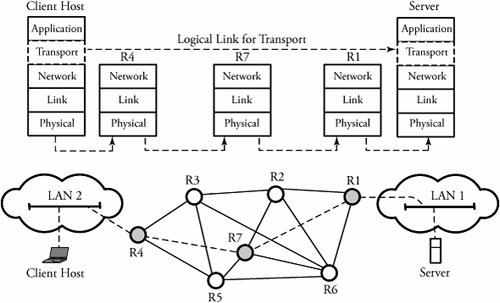Section 8.1. Transport Layer
8.1. Transport LayerThe transport layer handles the details of data transmission. This layer provides a logical communication between application processes, as shown in Figure 8.1. Transport-layer protocols are implemented in the end points but not in network routers. The transport layer ensures a complete data transfer for an application process, free from the issue of physical infrastructure. This layer clearly acts as an interface protocol between a communicating host and a network. For example, a client host in LAN 2 is running an application on a server through a logical link. However, the end points can be on the opposite sides of the network, connected via a number of routers, as shown by the two end points via R4-R7-R1. Figure 8.1. Demonstrating "logical" end-to-end communication between a client host and a server at the transport layer The two most important forms of transportation in the TCP/IP network are governed by two protocols:
TCP is connection oriented and is therefore a reliable service to an invoking application. On the contrary, UDP is a connectionless service and is unreliable to the invoking application. A network application design involves making a careful choice between these two transport protocols, as each acts differently to any invoking application. The transport layer converts application messages into transport-layer packets known as segments . The layer manages all end-to-end communication details, such as packet segmentation, packet reassembly, and error checking. The segmentation is performed by breaking the application messages into smaller chunks and attaching a transport-layer header to each chunk to create a segment. Once a segment is formed , it is passed to the network layer, where it is encapsulated within a network-layer packeta datagramand transmitted to the destination. 8.1.1. Interaction of Transport and Network LayersThe direct logical link shown in Figure 8.1 reflects the fact that three routersR4, R7, and R1 act only on the network-layer fields of the datagram and never inspect the fields of the transport-layer segment. This resembles a direct logical, but not physical, link between the two end points. Once the segment is received by the end server, the network layer extracts the transport-layer segment from the datagram and makes it available to the transport layer. At the receiving end, the transport layer processes the segment by extracting the application data in the segment. Transport protocols can generally offer reliable data transfer service to a certain application in spite of the fact that the underlying network protocol can be unreliable owing to losing packets. A transport protocol can also use its own security procedures to guarantee that application messages are not intruded by unknowns. |
EAN: 2147483647
Pages: 211